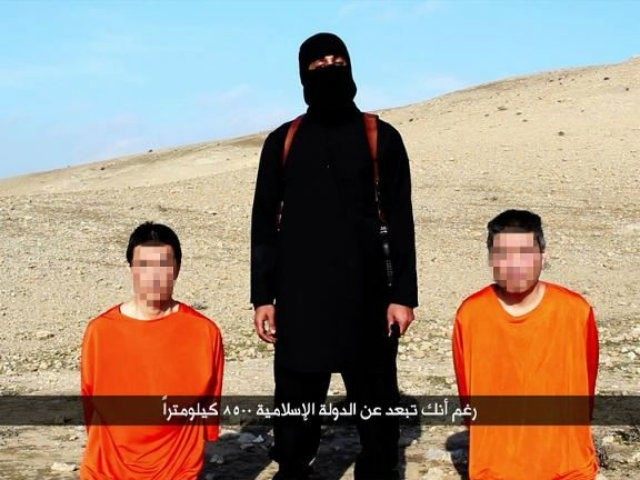Jihad John, the ISIS terrorist accused of beheading several western hostages, has appeared in a new video threatening to kill two Japanese men. Unlike previous videos the masked killer demands a ransom of $200 million ransom from the Japanese government – the same as their anti-terror budget – within 72 hours.
Within hours of the video emerging the Tokyo vowed it would not pay the ransom or give in to terrorism. ISIS has murdered five Western hostages since August last year, but it is the first time that the jihadist group has threatened Japanese captives.
As with previous videos the men, believed to be Kenji Goto and Haruna Yukawa, wore orange jumpsuits, similar to those used in Guantanamo Bay. Jihad John wore his familiar all black suit, with face covering. He was also carrying a knife.
In a Southern English accent he said: “You now have 72 hours to pressure your government into making a wise decision by paying the $200 million to save the lives of your citizens.”
The terrorist claimed the ransom demand is to compensate for non-military aid that Prime Minister Shinzo Abe pledged to support countries affected by the campaign against ISIS. He had made the pledge during his Middle East tour that sees him in Jerusalem today.
But the Japanese government said it would not bow to extremism. Chief government spokesman Yoshihide Suga said: “Our country’s stance, contributing to the fight against terrorism without giving in, remains unchanged.” Prime Minister Abe said: “It is unforgivable and I feel strong resentment.”
An official in the foreign ministry’s terrorism prevention division had said earlier that the government was investigating the threat and the authenticity of the video. Since August, ISIS has murdered three Americans and two Britons, posting grisly video footage of their executions.
US journalists James Foley and Steven Sotloff, American aid worker Peter Kassig and British aid workers Alan Henning and David Haines were all beheaded. So far, air strikes have proved ineffective at stopping those behind the videos but they are believed to have weakened ISIS.
The first hostage, Kenji Goto, is a freelance journalist who set up a video production company, named Independent Press in Tokyo in 1996, feeding video documentaries on the Middle East and other regions to Japanese television networks, including public broadcaster NHK.
The second hostage appeared in previous footage posted last August in which he identified himself as Haruna Yukawa and was shown being roughly interrogated by his captors.
Another online video that appeared at the time showed a man believed to be Yukawa test-firing an AK-47 assault rifle in Syria. The same video could be seen on the website of Tokyo-based private military firm PMC, which listed Yukawa as its chief executive.
Japanese culture values bravery and strength, it is therefore almost inconceivable that any government in the country would pay a ransom. Any payment would be seen as cowardice and therefore a national humiliation.
The new video has once again raised speculation about the whereabouts of British photojournalist John Cantlie. He has appeared in a number of propaganda videos, but instead of being tied up he is the presenter and seems to have some input into his script. Cantlie has stated that he is a captive and believes he will be killed, but his willingness to play along with ISIS has led to hopes he may be spared.
Additional reporting by AFP

COMMENTS
Please let us know if you're having issues with commenting.